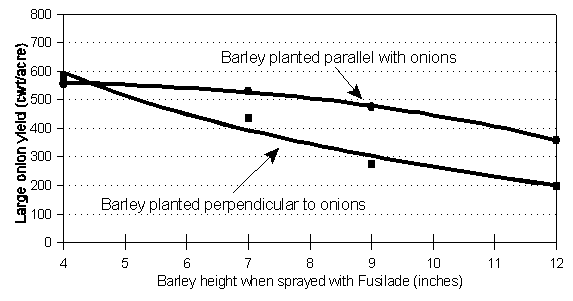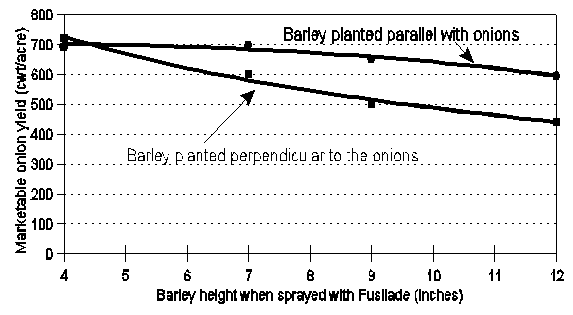
Oakes Irrigation Research
Site
Carrington Research Extension Center * North Dakota State University
P.O. Box 531, Oakes, ND 58474-0531, Voice: (701) 742-2189, FAX: (701)
742-2700, email: rgreenla@ndsuext.nodak.edu
ONION COVER CROP
STUDY
Richard Greenland
High winds, which occur frequently in the spring time in North Dakota, blow soil particles from the finely prepared onion seedbed across the ground, causing extensive damage to newly emerged onion plants. One way of stopping the destruction is by planting a cover crop. The taller the cover crop grows, the better it protects against wind damage. But if let grow too long it competes with the onions and reduces yield and quality. Our objective was to determine how long we could let the cover crop grow before we had to kill it to prevent it from reducing onion yield. In this study a cover crop of barley was drilled when the onions were planted. Onions were planted either perpendicular to or parallel with the rows of barley. The barley was then killed with Fusilade at different heights and data collected to determine the effect of the cover crop on onion production.
MATERIALS AND METHODS
| Soil: | Maddock sandy loam; pH=7.3; 2.5% organic matter; soil-P and soil-K were very high; soil-S was very low. |
| Previous crops: | 1997 - carrot; 1996 - sweet corn; 1995 - cabbage and broccoli. |
| Seedbed preparation: | Disked on 31 October 1997. Multiweeded (field cultivated) on April 15 to incorporate fertilizer and smooth the seedbed. |
| Planting: | On April 15, drilled barley cover crop (1 bu/acre, 6-inch rows) between and parallel to the onion rows or perpendicular to the onion rows. Direct seeded onions with a modified Stanhay vegetable planter (200,000 seeds/acre). Planted onions in paired rows (3 inches apart), with the paired rows on 16-inch centers. |
| Plots: | Plots were 6 ft wide by 17 ft long. The study had 4 reps. |
| Fertilizer: | On April 13, broadcast 14 lbs N/acre and 70 lbs P2O5/acre as 10-50-0, 16 lbs N/acre and 19 lbs S/acre as 21-0-0-24, and 94 lbs K20/acre as 0-0-60. Applied 69 lbs N/acre as urea on May 29. Sprayed 50 lbs N/acre as 28-0-0 on June 24. Fertigated 40 lbs N/acre as 28-0-0 on July 9. |
| Irrigation: | Overhead sprinkler irrigation as needed. |
| Pest control: | Weeds were controlled with: Prowl (1.5 pt/acre on May 11); Buctril + Goal (1.5 + 0.6 pt/acre on May 29 and June 25); Fusilade + nonionic surfactant (16 oz/acre + 1 pt/25 gal on June 25); and hand weeding. We sprayed with Ridomil (2.5 lbs/acre on June 26), Dithane (2.4 qt/acre on July 7), Manzate (3 lbs/acre on June 29, July 15, July 28 and Aug 13) and Rovral (1.5 pt/acre on July 23) to control diseases. No insect control needed. |
| Harvest: | Pulled onions approximately two weeks after half-down date. Onions were allowed to dry in the field until the first part of October when they were bagged and moved to a shed. The onions were graded Nov 2 to Nov 4. |
This was the fourth year we conducted studies on barley as a cover crop in onions. The general trend was for yields to decrease the longer the barley was allowed to grow before killing it. Yield decreased slowly (usually not significantly) until a barley height of 6 to 7 inches, then decreased more rapidly as the barley grew taller. The decrease was more pronounced when barley was planted perpendicular than when it was planted parallel to the onion rows (See Figures 2 and 3). Onion height was less, onion growth stage was retarded, and percent ground cover from the residue barley increased the longer the barley was allowed to grow. The total number of onion bulbs harvested did not change, but yield decreased due to smaller bulbs as barley height at spraying increased. Our recommendation is to plant the barley cover crop parallel with the onions. We modified a Stanhay vegetable planter by mounting a grain drill on top of it and closing some of the grain outlets so barley was drilled only between onion rows and never in the same row as the onions. This worked very well for us. We also recommend spraying the barley to kill it when it is about six inches tall. This protects the onions from most wind damage and has little, if any, effect on yield.
Return to top of onion cover crop study
Table 70. Response of onions and barley to the height of the barley cover crop when sprayed with Fusilade and the direction of planting of the barley cover crop. (Additional yield data is presented in Figures 2 and 3)
| Barley cover crop | Ratings taken on July 2 | Harvest data | |||||||
| barley height | onion height | onion leaves | ground cover† | number of bulbs | medium yield | small yield | Total yield | ||
| ------- inches ------- | % | 1000s/acre | ------------ cwt/acre ------------ | ||||||
| Height when sprayed | |||||||||
| 4 inches | 0.0 | 14.1 | 6.5 | 2 | 137 | 137 | 16 | 751 | |
| 7 inches | 0.4 | 12.3 | 6.0 | 18 | 142 | 166 | 22 | 704 | |
| 9 inches | 2.6 | 11.5 | 5.5 | 34 | 144 | 201 | 30 | 624 | |
| 12 inches | 5.8 | 11.0 | 5.2 | 39 | 148 | 239 | 39 | 569 | |
| LSD (0.05) | 0.9 | 0.8 | 0.4 | 12 | NS | 52 | 8 | 97 | |
| Planting direction‡ | |||||||||
| perpendicular | 2.6 | 12.0 | 5.6 | 28 | 142 | 193 | 32 | 617 | |
| parallel | 1.8 | 12.4 | 6.0 | 18 | 143 | 179 | 22 | 707 | |
| Probability§ | * | NS | NS | ** | NS | NS | * | * | |
| C.V. (%) | 40 | 6 | 7 | 48 | 10 | 27 | 30 | 14 | |
†Percent of ground covered with barley residue on July 2. Determined using the line intercept method using a 3-ft ruler and taking counts under each inch mark.
‡Direction of barley rows vs. onion rows.
§The probability that there is a difference between the values (between planting direction) in the same column is significant at the 0.05, 0.01, or 0.001 level for *, **, or ***, respectively. NS means no significant difference.
Return to top of onion cover crop study

Figure 2. Yield of large (greater then 3-inch diameter) onions vs. height of barley when sprayed with Fusilade. Circles and squares are actual mean values. Lines are regression curves.
Return to top of onion cover crop study

Figure 3. Marketable yield (onions greater than 2.25-inch diameter) vs. height of barley when sprayed with Fusilade. Circles and squares are actual mean values. Lines are regression curves.
Return to top of onion cover crop study
Go to Oakes Irrigation Research Site Cover Crop Studies page
Go to Oakes Irrigation Research Site 1998 annual report